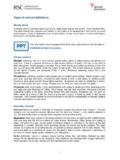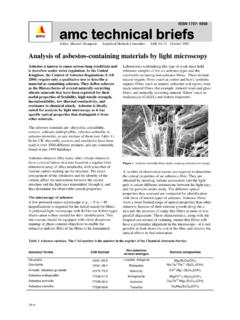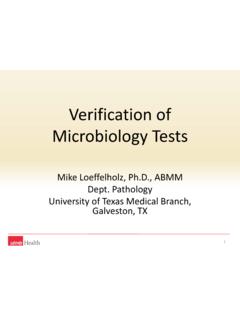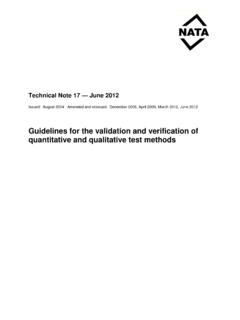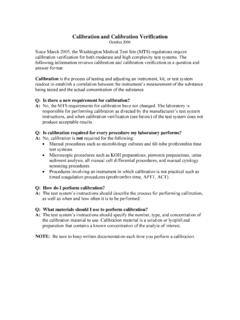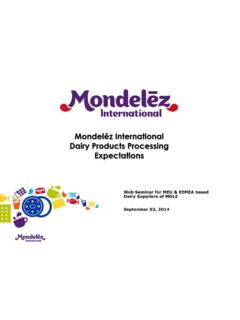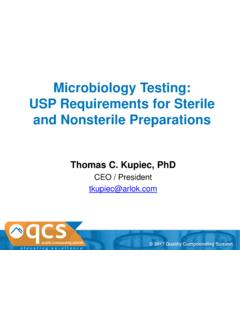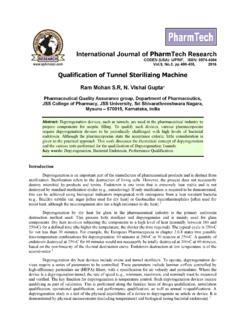Transcription of The UKAS approach to assessing quality control …
1 The UKAS approach to assessing quality controland ensuring consistencyAndrew Gawler, UKAS Technical AssessorBS EN ISO/IEC 17025:2005 General requirements for the competence of testing and calibration laboratories Applied to a wide range of laboratories not specifically for water microbiology. Sets out requirements for a laboratory quality system which includes technical and quality requirements quality assurance systems Verification of method performance Participation in proficiency testing schemes Internal quality control processesThe standard contains 59 clauses, of which 2 directly addressinternal quality control requirementsContained in section - Assuring the quality of test andcalibration results(Other clauses cover requirements for method validation andProficiency scheme participation)BS EN ISO/IEC 17025:2005 ISO17025 Requirements for AQCC lause states:The laboratory shall have quality control procedures for monitoring the validity of tests and calibrations undertaken.
2 The resulting data shall be recorded in such a way that trends are detectable and, where practicable, statistical techniques shall be applied to the reviewing of results. ISO17025:2005 Clause monitoring shall be planned and reviewed and may include,but is not limited to, the following ..regular use of CRMs and/or IQC participation in ILCs or PT programmesreplicate tests or calibrations using the same or : the selected methods should be appropriate for the type andvolume of work undertakenISO17025:2005 Clause control data shall be analysed and where theyare found to be outside pre-defined criteria, plannedaction shall be taken to correct the problem and to prevent incorrect results from being 17025:2005 quality assurance requirements Procedures in place to monitor the validity of tests andresults. Analysis of data to identify trends and non conformingresults.
3 Investigate identified failures and trends. Prevent incorrect results being reported. Standard gives some indication of the type of procedureswhich could be guidance documents EA 4/10 revision 02 (2002) UKAS publication LAB 37 edition 2 (2009) Other technical guidance documentsGuidance document EA 4/10EA - 4/10. Accreditation in MicrobiologicalLaboratoriesThis document has been produced by a joint EA/EURACHEM Working Group. It supplements ISO/IEC 17025 and provides specific guidance on the accreditation of laboratories performing microbiological 17025 remains the authoritative document against which findings are document EA 4/10 Contains specific guidance for both laboratories and assessors, which includes requirements Method validation. Traceability of reference strains. Internal quality control . External quality document EA 4 programme of periodic checks is necessary to demonstrate that variability ( between analysts and between equipment or materials etc.)
4 Is under control . All tests included in the laboratory s scope of accreditation need to be programme may involve: the use of spiked samples the use of reference materials (including proficiencytesting scheme materials) replicate testing replicate evaluation of test resultsDrinking Water Testing SpecificationUKAS publication Lab 37 (2009) AccreditationRequirements for Sampling and Testing in Accordancewith the Drinking Water Testing Specification (DWTS).Prepared by UKAS in collaboration with the Regulators, ie the Drinking Water Inspectorate of England and Wales (DWI), the Drinking Water quality Regulator for Scotland, and the Drinking Water Inspectorate for Northern sets out how the requirements of ISO 17025 and the UKAS Agreement shall be interpreted when applied to organisations undertaking sampling and/or testing of drinking water. Provides specific guidance which includes quality SCA Microbiology of Drinking Water (2002)Which contains detailed guidance on quality assurance, in the form of a range of optionsLab 37 (2009) The Assessment processISO 17025:2005 defines outcomes,It does not specify the processes by which these are to does however, for internal quality control suggest a numberof possible Assessment processAQC systems are assessed as part of the qualitysystemThe assessment team has to evaluate whether theAQC procedures adopted by a laboratory meet therequirements of the standard (or standards) anddeliver the required of AQC systemsThe quality system must include.
5 -Internal quality assurance systems for all accreditedparametersAnalysis of AQC data to identify non conforming results andtrendsThe systems adopted are fit for purpose deliver the required of AQCA ssessment of AQC systems is not done in isolation, alsoexamine:- Data from method re-verification Uncertainty of measurement calculations Proficiency scheme resultsContinuous improvementClause laboratory shall continually improve the effectiveness of its quality would include reviewing and evaluating developments in microbiological AQC practicesConsistencyUKAS needs to be consistent in its approach toassessment whilst allowing laboratories the flexibility todevelop quality systems which meet the requirements of the standard and is appropriate to the type and volume ofwork undertakenConsistencyUKAS strives for consistency through:- Careful selection of assessors and assessment managers Comprehensive training systems Reviews of individual assessor performance and feedback Annual assessor training events Annual meetings with water sector stakeholdersConsistencyStandardisation of methods and procedures lead toMore consistent assessmenteg.
6 The analytical methods documented in The Microbiology of Drinking Water (2002)The DWI Cryptosporium methodology UKAS representation on SCA Microbiology WG2 Conclusions AQC is assessed as part of the overall quality system The laboratory is responsible for the choice of processes used to provide AQC UKAS is responsible for assessing whether these procedures satisfy the requirements of ISO 17025 and where applicable UKAS has a range of procedures in place to encourage consistency within the assessment process. This process would be aided by developing more specific technical guidance within UK / EuropeQuestions ?
